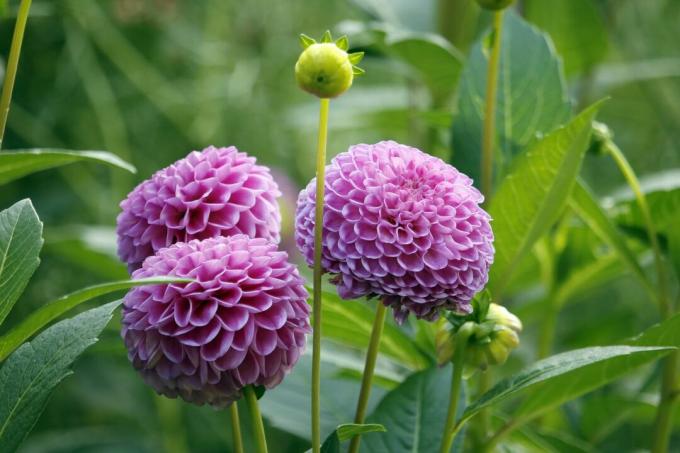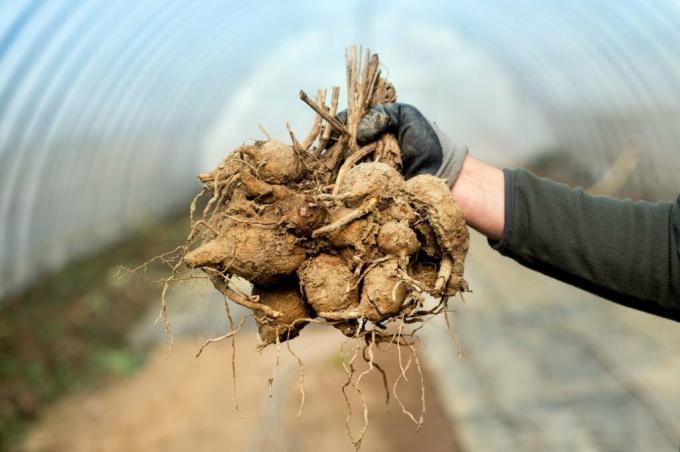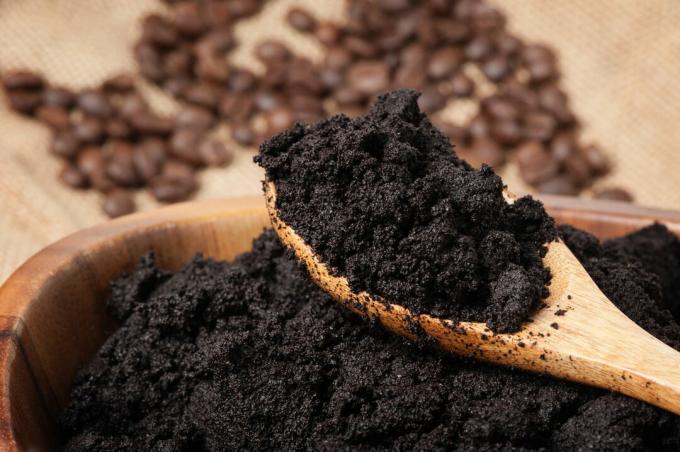In order for the dahlia to please us with its beautiful flowers, it needs a few extra nutrients. We show what you should consider when fertilizing dahlias.

Those from South America dahlias (dahlias) transform your garden into a bright sea of blossoms from July until the first frost in autumn. The queen of late summer shows a wide variety of flower colour, shape and size. Everything is represented, from large pompom-shaped flowers to pointed, narrow flowers like those of the cactus dahlia. But whichever variety you choose, the eye-catching flowering beauty must be adequately cared for. This allows her to develop her magnificent flowers over the summer.
Why do dahlias need fertilizer?
Dahlias need sufficient nutrients because they belong to the group of heavy feeders. That's no wonder when you consider that the pretty ornamental plant develops new leaves and impressive flowers every spring and keeps them on display until autumn. Potassium and phosphorus in particular are important for this and must also be made available organically or minerally. Of course, nitrogen must not be missing as the third important nutrient component. Too much nitrogen, however, can mean that the plant puts its energy into strong leaf growth and flowering is neglected. So that this does not happen, we will show you which fertilization options are available and how you can best proceed.
When should you fertilize dahlias?
When it comes to fertilizing, timing is key. The first nutrient accumulations begin in autumn, long before the dahlias are planted. This only happens in the spring, when the danger of frost has passed. In autumn, after the frost-sensitive tubers have been dug up, the soil can already be loosened and covered with well-rotted stable dung or mature compost be mixed. The first real fertilization takes place in the spring to give the flowering beauty a good jump-start.

Exactly when fertilization takes place depends on the type of fertilization. While organic fertilizer such as mature compost is incorporated into the soil prior to planting, mineral fertilization is carried out only a few weeks after planting, after the young shoots have appeared are. The second fertilization is then carried out with mineral and organic fertilization in July, shortly before flowering, in order to give it a last boost to particularly beautiful flowers. From the end of August there should be no more fertilization. Otherwise the tubers cannot mature sufficiently and their storability is thus endangered. This is especially true for fertilizers rich in nitrogen.
What is the best way to fertilize dahlias?
You can fertilize your dahlias organically, primarily organically or minerally. Organic Fertilizers, how compost or Damn are of plant or animal origin and more sustainable in production. Due to their natural release in the soil, they ensure an even flow of all necessary nutrients and a healthy soil life. Mineral fertilizers are made from fossil raw materials and atmospheric nitrogen and also contain nutrients such as nitrogen, phosphorus and potassium. They are usually available more quickly for the plants, but this can also lead to over-fertilization if the wrong dosage is used. In addition, excess nutrients can be washed out into the groundwater much more easily, which is why more attention must be paid to the dosage. Also for some other reasons, mineral fertilizers are such blue grain not optimal what you read about in our article mineral fertilizers can read in more detail.
Fertilize dahlias primarily organically: Instructions for application
Organic fertilization not only has a positive effect on the plant, but also improves the soil at the same time, which is why it is generally preferable to mineral fertilization. Dahlias love loose, warm and moist soil that has good drainage. If your soil does not meet these conditions, you can bring it closer to this ideal with the help of primarily organic fertilization.

If you primarily fertilize your dahlias organically, the first dose is best given two weeks before planting. Here it makes sense to mix two hands of well-rotted compost per tuber with the potting soil. Other organic fertilizers such as horn meal can also be used here. However, since horn meal contains little potassium, fertilizers that are high in potassium and phosphorus should also be used. Ours, for example, provides an extra portion of potassium Plantura organic flower fertilizer, which provides the plant with all the important nutrients over a long period of time and completely dispenses with animal ingredients. The second fertilization can then be done in July before the start of flowering with the Plantura flower & balcony fertilizer respectively.
So that everything works when fertilizing, we have a short guide for ours Organic flower fertilizer written for you.
Step-by-step instructions for fertilizing dahlias:
- Mix Plantura organic flower fertilizer with the potting soil: 100 - 150 g fertilizer per m² of area to be covered
- Place the dahlia bulb in the planting hole and cover with the enriched soil
- Pour well so that the granules can soften and the microorganisms have better access
- In July, before flowering begins, fertilize again with 80 - 120 g/m² of our Plantura organic flower fertilizer
Fertilize dahlias minerally with blue grain and co
If you prefer to fertilize with minerals, it is sufficient with long-term fertilizers to supply the ornamental plant with additional nutrients twice during the growing season. The first dose is given about four weeks after planting, when the young shoots appear, to give the plant a small boost of energy. The second dose is then in July before the start of flowering for particularly magnificent flowers. However, if you use a cheaper mineral fertilizer without a long-term effect, the fertilizer should be applied in small doses every 4-6 weeks to ensure an even supply. With all mineral fertilizers, care must be taken to ensure that the grains are not distributed on open roots or directly on the main shoot.
In general, it is important to keep in mind that dahlias do not tolerate heavy, wet, or cold soils. We strongly advise against exclusively mineral fertilization. Sustainable gardening and an associated, long-term healthy soil life only works if soil organisms are promoted by organic fertilization.
Fertilize dahlias with home remedies
Do you like drinking coffee? Then you already have a good home remedy for fertilizing dahlias with your coffee grounds. One Fertilization with coffee grounds brings nitrogen into the soil and with its addition creates a slightly acidic pH value, which dahlias do as well roses (pink),hydrangeas (Hydrangea) or violet (viola) well tolerated. And the fertilizer made from coffee grounds has another plus point: it keeps them snails away, who especially like to eat the young shoots of the dahlias. Also, he draws worms magically, which are a welcome guest in every garden floor. For fertilization, the coffee is worked flat into the soil. It is important not to forget to dry it beforehand, otherwise it can quickly start to mold in the bed. To dry, you can simply spread the coffee grounds out flat on a tray or plate overnight.

Tip: Of course, coffee grounds alone are not sufficient as a full fertilizer for the heavily consuming dahlia. So if you want to upgrade your coffee fertilizer a bit, you can mix it with ours in a ratio of 3:1, for example Plantura organic flower fertilizer Mix. Are you also interested in caring for dahlias? Then you will find all information and tips about the in our special article dahlia care.


